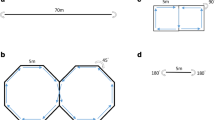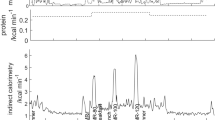Summary
Three hundred and six measurements of energy expenditure by indirect calorimetry of sitting at rest and self-paced activity were made on 41 men, 48 women and 6 adolescents in a mountain village of Nepal. Except for walking and carrying uphill, measured activities fell within the range of values for light to moderate effort, despite appearing physically demanding. Villagers tended to reduce travel speed when carrying heavy loads (54–102% of body mass on various inclines), averaging a moderate level of energy expenditure which could be sustained throughout the day. Such moderately demanding work was also assumed by pregnant, lactating women and young adolescents. Pregnant women worked more slowly at some tasks, but did not differentiate themselves from their non-pregnant, non-lactating counterparts for travel on the mountain side.
Similar content being viewed by others
References
Balogun JA, Robertson RJ, Goss FL, Edwards MA, Cox RC, Metz KF (1986) Metabolic and perceptual responses while carrying external loads on the head and by yoke. Ergonomics 29:1623–1635
Beall CM, Goldstein MC (1988) Sociocultural influences on the working capacity of elderly Nepali men. In: Collins KJ, Roberts DF (eds) Capacity for work in the tropics. Cambridge University Press, Cambridge, pp 215–226
Bleiberg FM, Brun TA, Goihman S (1980) Duration of activities and energy expenditure of female farmers in dry and rainy seasons in Upper-Volta. Br J Nutr 43:71–82
Brun T, Bleiberg F, Goihman S (1981) Energy expenditure of male farmers in dry and rainy seasons in Upper-Volta. Br J Nutr 45:67–75
Collins KJ (1990) Introduction. In: Collins KJ (ed) Handbook of methods for the measurement of work performance, physical fitness and energy expenditure in tropical populations. International Union of Biological Sciences (IUBS), Paris, pp 9–12
Collins KJ, Brotherhood RJ, Davies CTM, Dore C, Hackett AJ, Imms FJ, Musgrove J, Weiner JS, Amin MA, El Karim M, Ismail HM, Omer AHS, Sukkar MY (1976) Physiological performance and work capacity of Sudanese cane cutters with Schistosoma mansoni infection. Am J Trop Med Hyg 25:410–421
Durnin JVGA (1978) Indirect calorimetry in man: a critique of practical problems. Proc Nutr Soc 37:5–12
Durnin JVGA, Passmore R (1967) Energy, work and leisure. Heinemann, London
FAO/WHO/UNU Expert Consultation (1985) Energy and protein requirements. Technical Report Series 724, World Health Organization, Geneva
Ferro-Luzzi A (1988) Marginal energy malnutrition: some speculations on primary energy sparing mechanisms. In: Collins KJ, Roberts DF (eds) Capacity for work in the tropics. Cambridge University Press, Cambridge, pp 141–164
Fox RH (1953) Energy expenditure of Africans engaged in various rural activities. Ph. D. Thesis, London University
Harrison GA (ed) (1982) Energy and effort. Taylor and Francis, London
Henry CJK, Rees DG (1988) A preliminary analysis of basal metabolic rate and race. In: Blaxter K, Macdonald I (eds) Comparative nutrition. Libbey, London, pp 149–158
James WPT, Schofield EC (1990) Human energy requirements: a manual for planners and nutritionists. Oxford University Press, New York
Lawrence M (1988) Predicting energy requirements: is energy expenditure proportional to the BMR or to body weight? An analysis of data collected in rural Gambian women. Eur J Clin Nutr 42:919–927
Lawrence M, Singh J, Lawrence F, Whitehead RG (1985) The energy cost of common daily activities in African women: increased expenditure in pregnancy? Am J Clin Nutr 42:753–763
Legg SJ, Mahanty A (1985) Comparison of five modes of carrying a load close to the trunk. Ergonomics 28:1653–1660
Maloiy GMO, Heglund NC, Prager LM, Cavagna GA, Taylor CR (1986) Energetic costs of carrying loads: have African women discovered an economic way? Nature 319:668–669
Muller EA (1953) Physiological basis of rest pauses in heavy work. Q J Exp Physiol 38:205–215
Norgan NG, Ferro-Luzzi A, Durnin JVGA (1974) The energy and nutrient intake and the energy expenditure of 204 New Guinean adults. Philos Trans R Soc Lond [Biol] 268:309–348
Panter-Brick C (1989) Motherhood and subsistence work — the Tamang of rural Nepal. Hum Eco 17:205–228
Panter-Brick C (1992) Women's working behaviour and maternal-child health in rural Nepal. In: Norgan N (ed) Physical activity and health. Cambridge University Press, Cambridge (in press)
Phillips PG (1954) The metabolic cost of common West African agricultural activities. J Trop Med 57:12–20
Prentice AM (1984) Adaptations to long-term low energy intake. In: Pollitt E, Amante P (eds) Energy intake and activity. Current topics in nutrition and disease, vol 2. Liss, New York, pp 3–31
Shetty PS (1984) Adaptive changes in basal metabolic rate and lean body mass in chronic undernutrition. Hum Nutr Clin Nutr 38C:443–451
Thomas RB, Leatherman TL, Carey JW, Haas JD (1988) Biosocial consequences of illness among small scale farmers — a research design. In: Collins KJ, Roberts DF (eds) Capacity for Work in the tropics. Cambridge University Press, Cambridge, pp 249–276
Torun B, McGuire J, Mendoza RD (1982) Energy costs of activities and tasks of women from a rural region of Guatemala. Nutr Res 2:127–136
Waterlow JC (1990) Mechanisms of adaptation to low energy intakes. In: Harrison GA, Waterlow JC (eds) Diet and disease. Cambridge University Press, Cambridge, pp 2–23
Weir JB de V (1949) New methods for calculating metabolic rate with special reference to protein metabolism. J Physiol (Lond) 109:1–9
Author information
Authors and Affiliations
Rights and permissions
About this article
Cite this article
Panter-Brick, C. The energy cost of common tasks in rural Nepal: levels of energy expenditure compatible with sustained physical activity. Europ. J. Appl. Physiol. 64, 477–484 (1992). https://doi.org/10.1007/BF00625071
Accepted:
Issue Date:
DOI: https://doi.org/10.1007/BF00625071




